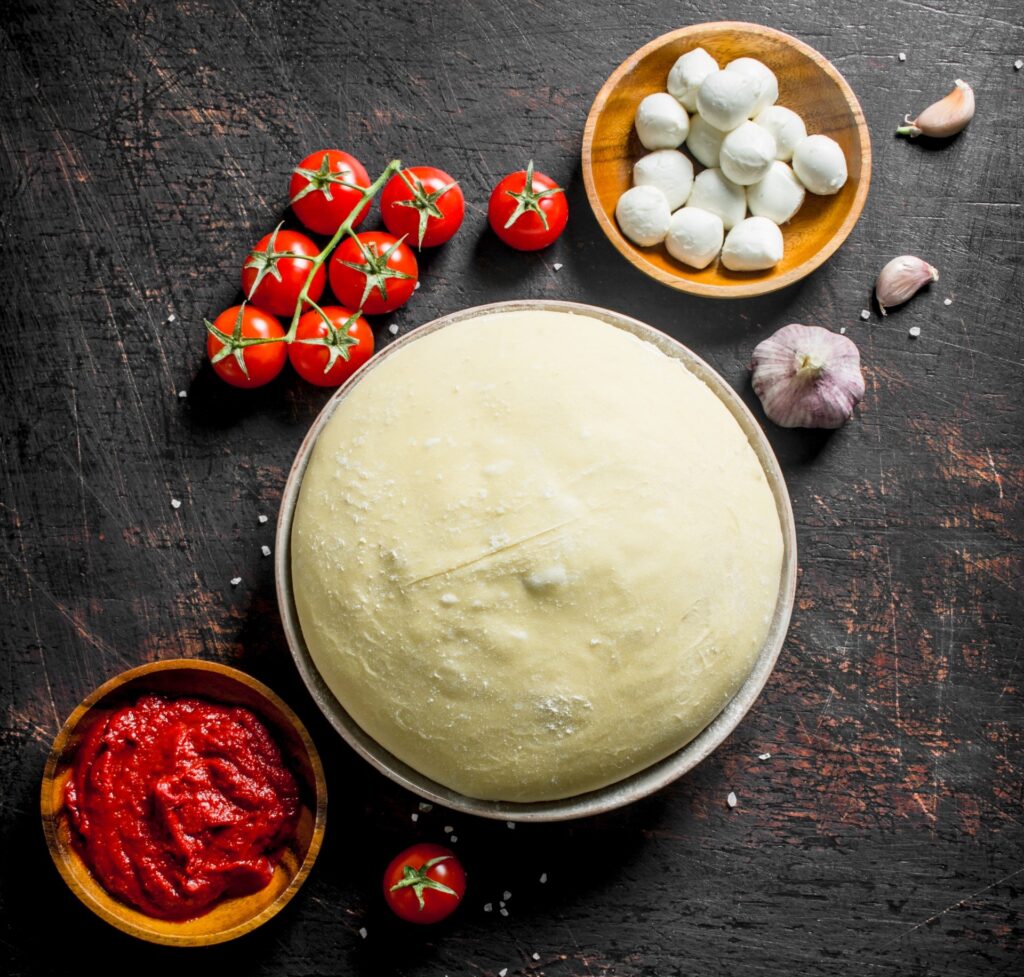Have you ever made pizza dough and found out that it didn’t rise? You’re not alone. Yeast does a lot in pizza dough, but little mistakes can leave you with flat, dense, or tough crusts that do not give the perfect bite that a pizza should have.
Whether you’re a home baker learning how to bake better pizzas or you’re just curious how Manny & Olga’s has mastered those legendary pillowy crusts, you’re in the right place!
This article will help you understand yeast and common yeast issues, and we will discuss what mistakes should be avoided and what fixes you can do to help your dough rise properly, every time. After all, great pizza starts with great dough!
Understanding Yeast in Pizza Dough
Yeast is not an ingredient, it is a living organism. While feeding on sugar, it releases carbon dioxide that causes the dough to expand and creates the air pockets that make your crust so lovely. Yeast is a unique organism that prefers specific conditions to thrive—warmth, moisture, and sugar to activate.
The type of yeast you are using can make a considerable difference in how the dough works. Active dry yeast needs to be dissolved in water, instant yeast can be added directly with your dry ingredients, and fresh yeast (what Manny & Olga’s uses for certain doughs) has its own characteristics.
If your yeast for your pizza dough is inactive or mishandled, your dough can stay flat. Understanding some of the science behind how yeast works can help troubleshoot almost any issue you have with pizza dough.
Common Pizza Dough Problems & How to Fix Them
Problem 1 – My Dough Isn’t Rising at All
Why It Happens:
- Expired or dead yeast: Even yeast that’s within its expiration date can die if stored improperly. Heat and moisture are yeast’s enemies when in storage.
- Water temperature issues: Water above 120°F will kill yeast instantly. Water below 90°F won’t activate it efficiently, especially in cold kitchens.
- Insufficient fermentation time: Different environments require different rising times. In cooler rooms, yeast works much more slowly.
- Salt directly contacted yeast: If salt touches yeast before it’s mixed into dough, it can dehydrate and kill the yeast cells.
Fixes:
- Test your yeast before using: Mix it with warm water (100-110°F) and a pinch of sugar. Wait 10 minutes – if it doesn’t foam and bubble actively, it’s dead and should be replaced.
- Use a thermometer: Don’t guess on water temperature – a few degrees can make the difference between perfect activation and dead yeast.
- Create a warm environment: Place dough in an oven with just the light on, or on top of a refrigerator where ambient heat collects. Cover with a damp cloth to prevent the surface from drying out.
- Add a pinch of sugar: Yeast feeds on sugar, so adding a small amount can jump-start the activation process, especially in whole-grain doughs.
- Mix salt carefully: Add salt only after yeast has been incorporated into the flour mixture, never directly into the water with yeast.
Problem 2 – My Dough Rose Too Little and Feels Dense

Why It Happens:
- Incorrect yeast-to-flour ratio: Different recipes require different amounts of yeast. High-hydration doughs typically need less yeast than drier ones.
- Salt inhibition: While salt is necessary for flavor and to control fermentation, too much can slow yeast activity dramatically.
- Improper kneading technique: Under-kneading fails to develop the gluten structure needed to trap gas bubbles. Over-kneading breaks down gluten, causing dense results.
- Flour with low protein content: Low-protein flour (like cake flour) doesn’t develop enough gluten to support a good rise.
- Cold ingredients: If flour or other ingredients are cold from storage, they can slow down yeast activity significantly.
Fixes:
- Increase the yeast amount slightly (¼ teaspoon more for a standard recipe) and avoid adding salt directly onto the yeast.
- Knead dough until smooth and elastic—about 8-10 minutes by hand or 5-7 minutes in a mixer.
- Allow more fermentation time. At Manny & Olga’s, we know that patience creates better texture—try cold fermentation in your refrigerator for 24-72 hours.
Problem 3 – My Dough Over-Rose and Collapsed
Why It Happens:
- Excessive fermentation time: Left too long, the yeast depletes its food source, and the gluten structure begins to break down.
- Too much yeast: Excessive yeast creates a rapid rise that the gluten structure can’t support.
- Temperature fluctuations: Sudden temperature changes can shock the yeast and cause collapse.
- Weak flour: Some all-purpose flours don’t have enough protein to maintain structure during extended rises.
- High sugar content: While sugar feeds yeast, too much can cause hyperactivity followed by collapse.
Fixes:
- Use weight, not volume: Measure flour by weight (grams or ounces) rather than cups for consistency. At Manny & Olga’s, we weigh all ingredients for perfect consistency.
- Add flour gradually: Never add all the flour at once – reserve about 20% to add as needed while kneading.
- Adjust for weather: Reduce water by 5-10% on very humid days; increase it on dry days.
- Master the feel: Properly developed dough should feel tacky but not sticky – it should clear the sides of the bowl but stick slightly to the bottom.
- Rest the dough: Let the mixed dough rest for 15-30 minutes before kneading (autolyse) to allow the flour to fully hydrate, often solving apparent dryness.
- Use the right technique: For wet doughs, use a stretch-and-fold technique rather than traditional kneading to develop gluten without adding excess flour.
- Adjust hydration gradually: Add water a teaspoon at a time for dry dough; add flour a tablespoon at a time for wet dough.
Problem 4 – My Dough is Sticky or Too Dry
Why It Happens:
- Humidity affects flour: On humid days, flour absorbs moisture from the air; on dry days, it’s more arid than usual.
- Measuring inconsistencies: Volume measurements (cups) can vary by 20% depending on how you scoop.
- Different flour absorption rates: Whole grain flours absorb significantly more water than white flours.
- Oil incorporation issues: Inadequate mixing can leave some parts of dough oily and others dry.
- Protein content variations: Higher protein flours require more water to achieve the same consistency.
Fixes:
- Add flour gradually during mixing and adjust based on feel—dough should be soft but not sticky.
- Knead longer to develop elasticity and structure.
- If too dry, slowly add teaspoons of water until the dough becomes soft and pliable.
How Manny & Olga’s Ensures Perfect Dough Every Time
We have come to take great pride in our dough, which has been a work in progress for decades. By carefully weighing the ingredients we use and drawing on a rich tradition of fermentation methods that have been carried on by generations of pizza makers, we developed dough that might develop unexpectedly, but will always develop!
As yeast ferments our pizza dough, we have to be cautious to handle it at a temperature where a good rise will always be present in order to yield the light and airy crust our customers love so much. We found the bulk fermentation will be much longer, giving the dough time to develop complex flavors along with the best texture of the crust if we handled it cold, controlled temperatures.
These thoughtful steps, combined with great ingredients, result in a completely different pizza offering that stands out in the DC area. It is not like following a recipe, but understanding from firsthand experiences how the organism of yeast brings pizza dough to life.
Troubleshooting Yeast = Better Pizza

Dealing with yeast issues can be irritating, but these minor changes can have a huge impact on how your pizza comes out. By knowing why your dough isn’t rising and applying these simple tweaks will give you the light, fluffy pizza you are aiming for.
At Manny & Olga’s, we go through the process of perfecting this daily so we can serve our customers the best product possible. Our commitment to dough perfection is just part of our overall commitment to quality in everything we serve.
So, the next time you eat at Manny & Olga’s, sit back and appreciate that you have mastered yeasty dough! Craving a pizza made with perfectly fermented dough? Order from Manny & Olga’s today!
